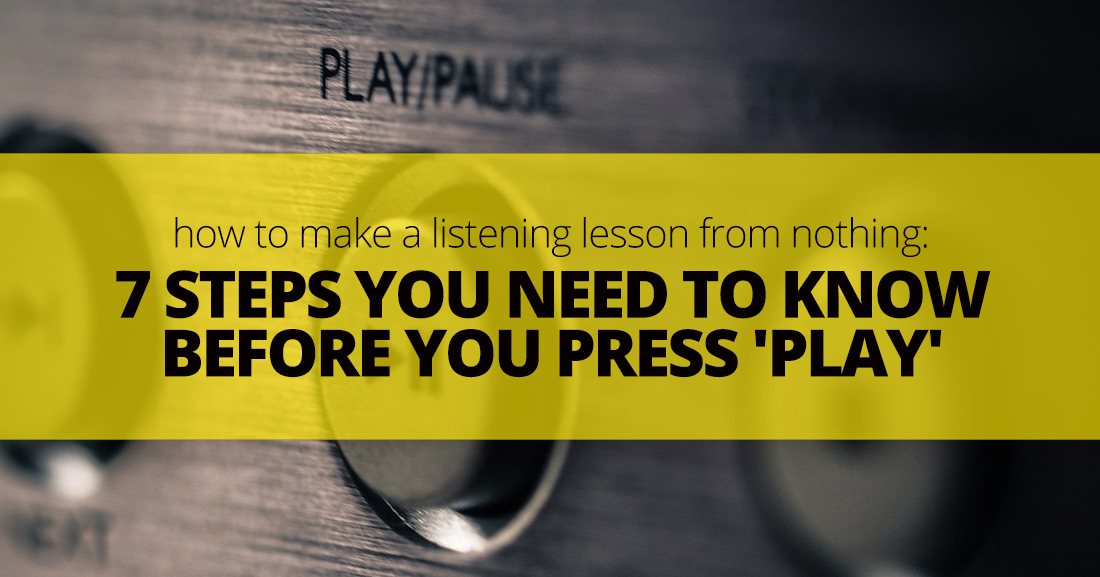How To Make A Listening Lesson From Nothing: 7 Steps You Need To Know Before You Press 'Play'


Do you feel limited by or bored with the recordings that came with your text book? Don’t be discouraged if your answer is yes. It’s easier than you might think to create your own audio recordings to use in class. It only takes a few simple steps, and you can have material you are confident in and excited to use with your students. Here’s how.

Before you can do any recording, you’ll have to figure out how you are going to record your conversations. If you have a computer or a phone, you probably already have the resources you need to make recordings for your class. But you might also consider using a good ole tape recorder, an electronic recording device, or even a recording app like Audacity. Whatever you choose to do, make sure the recordings are clear and audible. Which leads us to the next most important piece of equipment – your speakers. How will you present your recording to your class? Make sure that your playback equipment is audible and clear so the sound quality doesn’t interfere with your students’ abilities to understand what is being spoken.
You probably already know what grammar points you want to cover in your audio conversation, so it likely won’t take much time to think about this step in the process. It may be more challenging to define how that grammatical concept fits into a conversation naturally. Here’s a hint. Look at the examples your text book gives for the target structure and plan on using a similar scenario for your recording.
If you are like me, you teach your ESL classes with a theme in mind. Often the theme ties into a vocabulary unit, but that is not always the case. Typical ESL units include sports, food, family, travel, and others, but you don’t have to stick to these themes. I’ve also taught units on controversial topics, ethical businesses, etc. If you already have a theme that you are teaching, tie your conversation topics into that. If you don’t, see if the vocabulary you are teaching naturally lines up with a certain theme. If not, choose something either you or your students are interested in and just go with it.
Think about the vocabulary you want to use in your recording. Of course, you will be limited to some extent. You can’t exactly have a conversation without using the basic building blocks of sentences. But you can also enrich your students’ experience with the recording by intentionally including some unfamiliar vocabulary. It’s always an option to teach these words before you present them in the audio, but I find it even better to challenge students to guess the meaning of the words from their context. When they listen closely and determine meaning from context, your students will make better brain connections with these new words than they would if you started with a translation of them into their L1. Keep in mind, however, that you should not use the first time listening through a conversation to come up with tentative definitions of new words. Save that till the second or third time through the recording.
You could just ask a couple of friends to talk into a recording device and play that for your students. There are advantages to using unscripted and unrehearsed conversations in class. But it is more practical for instructional purposes (and more respectful of your volunteers’ time) to have something prepared ahead of your recording session. Since you know what you want to teach your students, you can be sure to include the target grammar and vocabulary in your script. You can tie your theme in by setting the conversation in a location or on a topic that ties into that theme. For example, if you are teaching a unit on sports, you might have a conversation between a little league coach, a child, and the child’s parent. Keep in mind that you need at least two people to record each conversation, but you aren’t limited to two. Sometimes having three or even four speakers is advantageous for your students even if it is far more challenging.
Bringing audio recordings into your classroom is a fantastic and inexpensive way to introduce your students to new voices and flavors of spoken English. Your friends will be your first and best resource for voice actors since they won’t have to do any acting at all. They will just be reading a script you have already prepared. When you make your audio recordings, try to get as large a variety of speakers you can. Use men and women, people with different voice pitches and accents, and even elderly and young speakers (these will probably present the biggest challenge to your language learners). Of course you can use your own voice, but your students hear that all the time. The more variety you can include in your homemade recordings, the more exposure your students will have to real life language variety. As much as they might like listening to you, you won’t be with them for their entire English speaking future, so preparing your students to hear and understand different types of voices is one of the best things you can do for them.
Now that you have all the pieces in place, it’s time to record. It’s up to you and your volunteers whether you record several conversations in one session or if you limit yourselves to one conversation per recording session (though I would recommend just recording one during your very first session just to make sure there aren’t any changes you need to make before the next one). Either way, do a test recording of yourself to double check your equipment before your volunteers show up. When they get there, give them the scripts and let them do a practice read through. When you record, don’t panic if your speakers don’t stick exactly to your script. It’s actually better for your students if the conversation sounds more natural even if it doesn’t follow exactly what you have written. After you record, take a quick listen and make sure your conversation recorded correctly.
Seven simple steps and you are ready to present your original conversations to your students. They will be on topic, include what you want to teach your class, and be realistic. After using one recorded conversation in class take a few minutes to evaluate what was good about it and anything you might need to change before recording the next one. And save your recording so you can use it again the next time you teach this class.